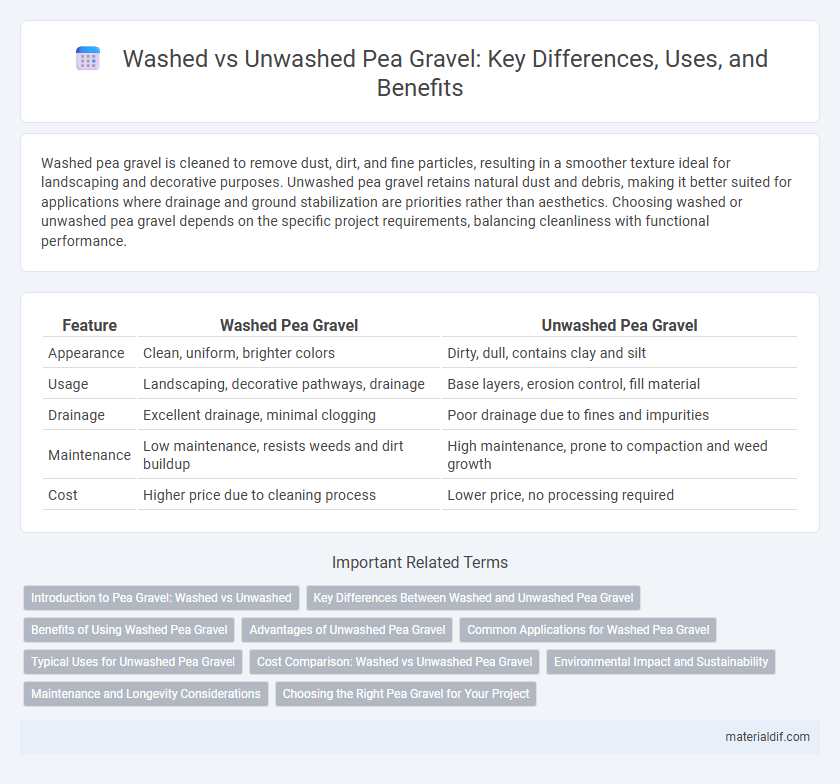Washed pea gravel is cleaned to remove dust, dirt, and fine particles, resulting in a smoother texture ideal for landscaping and decorative purposes. Unwashed pea gravel retains natural dust and debris, making it better suited for applications where drainage and ground stabilization are priorities rather than aesthetics. Choosing washed or unwashed pea gravel depends on the specific project requirements, balancing cleanliness with functional performance.
Table of Comparison
| Feature | Washed Pea Gravel | Unwashed Pea Gravel |
|---|---|---|
| Appearance | Clean, uniform, brighter colors | Dirty, dull, contains clay and silt |
| Usage | Landscaping, decorative pathways, drainage | Base layers, erosion control, fill material |
| Drainage | Excellent drainage, minimal clogging | Poor drainage due to fines and impurities |
| Maintenance | Low maintenance, resists weeds and dirt buildup | High maintenance, prone to compaction and weed growth |
| Cost | Higher price due to cleaning process | Lower price, no processing required |
Introduction to Pea Gravel: Washed vs Unwashed
Washed pea gravel undergoes a cleaning process to remove dirt, dust, and fine particles, resulting in a cleaner, brighter appearance ideal for landscaping and decorative uses. Unwashed pea gravel retains natural dirt and debris, making it more affordable and suitable for drainage applications where cleanliness is less critical. Understanding these differences helps determine the best option for specific projects like walkways, driveways, or garden beds.
Key Differences Between Washed and Unwashed Pea Gravel
Washed pea gravel undergoes a thorough cleaning process to remove dirt, dust, and fine particles, resulting in a cleaner and more aesthetically pleasing appearance compared to unwashed pea gravel. Unwashed pea gravel retains natural sediments and clay, which can cause it to be dusty and less visually appealing, making it more suitable for less decorative uses such as base layers or drainage. The key differences between washed and unwashed pea gravel lie in cleanliness, appearance, and intended application, with washed gravel favored for landscaping and decorative projects while unwashed gravel is often reserved for functional purposes.
Benefits of Using Washed Pea Gravel
Washed pea gravel offers superior cleanliness by removing dirt, dust, and debris, creating a more aesthetically pleasing and hygienic surface for landscaping and pathways. Its improved drainage capabilities reduce water retention, preventing erosion and promoting healthier soil conditions. The uniform texture and appearance of washed pea gravel enhance overall durability and maintainability in outdoor projects.
Advantages of Unwashed Pea Gravel
Unwashed pea gravel retains natural minerals and fine particles that enhance soil nutrient content and promote plant growth in landscaping applications. Its rough texture provides superior traction and stability for pathways and driveways compared to washed gravel. Additionally, unwashed pea gravel is often more cost-effective due to lower processing requirements, making it an economical choice for bulk landscape projects.
Common Applications for Washed Pea Gravel
Washed pea gravel is commonly used in landscaping, drainage systems, and concrete mixes due to its clean, debris-free composition that enhances water flow and aesthetic appeal. It is ideal for pathways, patios, and garden beds where a smooth, uniform texture improves usability and visual consistency. This type of gravel also excels in filtration systems and erosion control projects by preventing clogging and promoting efficient water movement.
Typical Uses for Unwashed Pea Gravel
Unwashed pea gravel is commonly used in construction projects where dirt and debris do not affect functionality, such as in drainage systems, sub-base layers, and roadbed foundations. Its rough texture provides better compaction and stability, making it ideal for erosion control and landscaping where filtration is unnecessary. This type of pea gravel is cost-effective for large-scale applications where appearance is not a priority.
Cost Comparison: Washed vs Unwashed Pea Gravel
Washed pea gravel typically costs more than unwashed pea gravel due to the additional processing required to remove dirt and debris, enhancing its cleanliness and aesthetic appeal. Prices for washed pea gravel average between $40 to $80 per ton, while unwashed variants range from $30 to $60 per ton, making unwashed gravel a budget-friendly option for construction projects where appearance is less critical. The cost difference reflects the value added by washing, which improves drainage and reduces dust, potentially lowering maintenance expenses over time.
Environmental Impact and Sustainability
Washed pea gravel undergoes a cleaning process that removes dust, clay, and other fine particles, reducing soil contamination and runoff pollution, thereby supporting better water quality and environmental sustainability. Unwashed pea gravel contains fine sediments that may contribute to clogging and increased sedimentation in nearby waterways, potentially harming aquatic ecosystems and diminishing soil permeability. Choosing washed pea gravel helps promote sustainable landscaping practices by improving drainage efficiency and reducing the ecological footprint of construction and gardening projects.
Maintenance and Longevity Considerations
Washed pea gravel offers superior maintenance benefits by reducing dust and preventing dirt buildup, which extends the lifespan of surfaces and surrounding materials. Unwashed pea gravel, containing clay, silt, and organic matter, requires more frequent cleaning and can promote weed growth, leading to increased upkeep. Choosing washed pea gravel enhances drainage and durability, making it a cost-effective option for long-term landscaping projects.
Choosing the Right Pea Gravel for Your Project
Washed pea gravel offers cleaner, smoother stones ideal for pathways, drainage, and decorative landscaping, reducing dust and debris during installation. Unwashed pea gravel contains natural soil and clay, providing better compaction and stability for driveways and foundations where drainage is less critical. Selecting the right pea gravel depends on project requirements such as aesthetics, drainage needs, and ground stabilization to ensure optimal durability and performance.
Washed Pea Gravel vs Unwashed Pea Gravel Infographic

 materialdif.com
materialdif.com